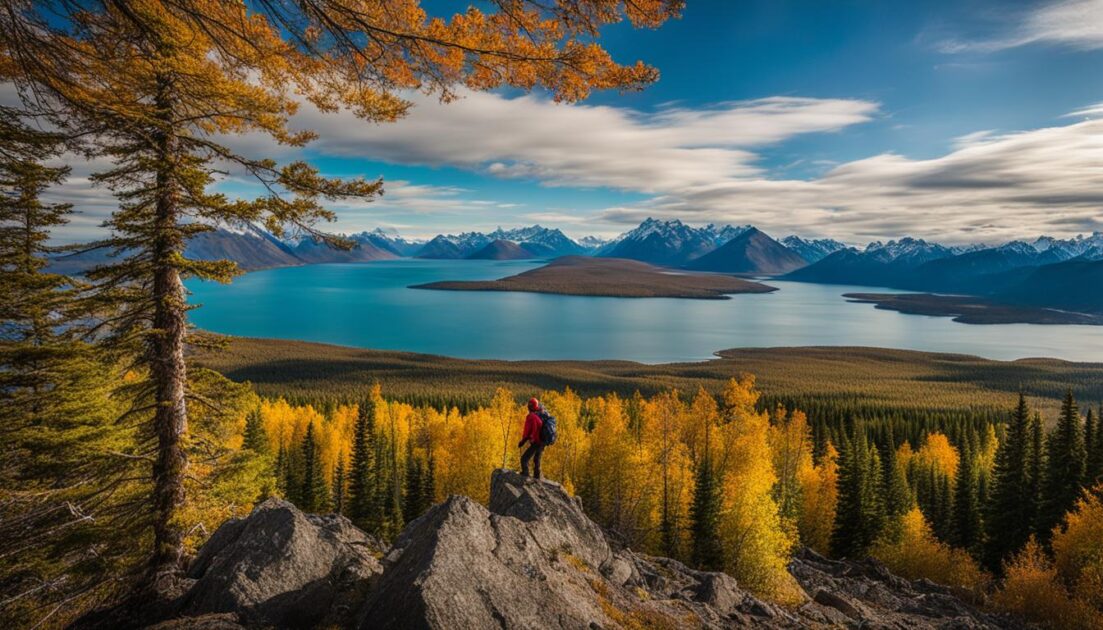Are you ready for an unforgettable hiking adventure in the wilderness? Look no further than Lake Clark National Park in Alaska. With its pristine landscapes, remote hiking trails, and abundant wildlife sightings, this park offers a true outdoor paradise for nature enthusiasts and adventure seekers. Whether you’re a beginner hiker or an experienced explorer, Lake Clark has something for everyone to enjoy.
As you embark on your hiking journey through Lake Clark National Park, you’ll have the opportunity to discover scenic trails, immerse yourself in the beauty of Alaska’s backcountry, and witness wildlife in their natural habitat. From picturesque lakes to breathtaking mountains, every step will bring you closer to the heart of this extraordinary park.
But before you hit the trails, here are some essential tips to ensure you make the most of your Lake Clark hiking experience:
Key Takeaways:
- Explore the stunning landscapes and wilderness of Lake Clark National Park.
- Choose from easy and hard trails based on your hiking skill level.
- Be prepared for changing weather conditions and pack appropriate gear.
- Experience the unique beauty of Lake Clark in both summer and winter.
- Learn about the park’s historical significance and cultural heritage.
Easy Hiking Trails in Lake Clark National Park
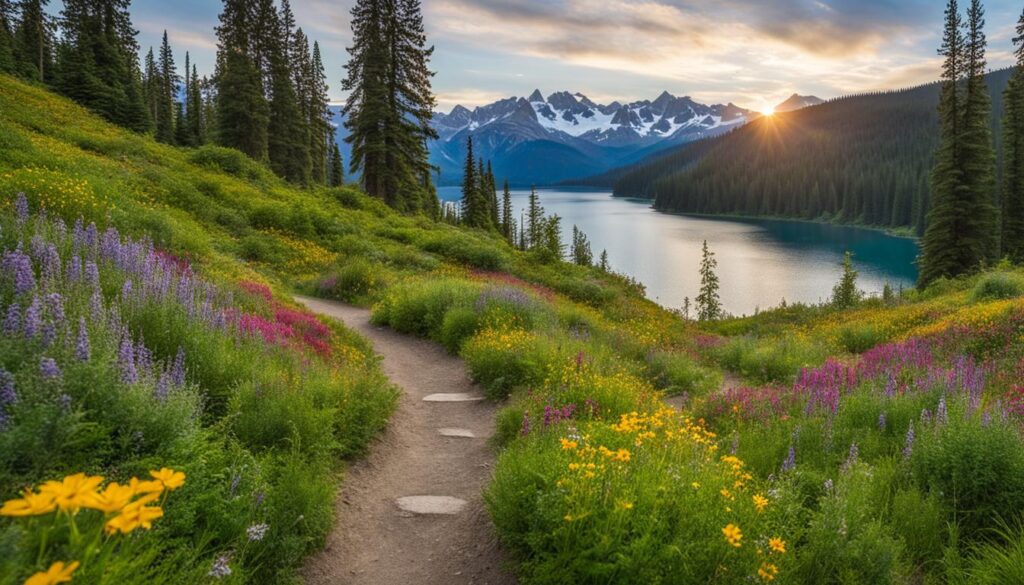
Lake Clark National Park offers a variety of easy hiking trails suitable for all skill levels. These trails provide opportunities to enjoy the park’s natural beauty, spot wildlife, and immerse yourself in the serene wilderness of Lake Clark. Some popular easy trails include the routes to Beaver Pond, Tanalian Falls, and Kontrashibuna Lake, near the visitors center in Port Alsworth. These trails offer stunning views of the surrounding landscapes, including mountains, lakes, and forests.
One of the highlights of hiking the easy trails in Lake Clark National Park is the chance to observe wildlife in their natural habitat. Keep an eye out for black bears, moose, and a variety of bird species. The park is also home to an abundant population of brown bears, and if you’re lucky, you might catch a glimpse of these majestic creatures fishing for salmon in the park’s rivers.
Whether you’re a beginner hiker or simply looking for a more relaxed outdoor experience, the easy hiking trails in Lake Clark National Park provide a wonderful opportunity to connect with nature and explore the beauty of this pristine wilderness.
Trail Difficulty Comparison
| Trail | Difficulty Level |
|---|---|
| Beaver Pond | Easy |
| Tanalian Falls | Easy |
| Kontrashibuna Lake | Easy |
“The easy hiking trails in Lake Clark National Park provide a wonderful opportunity to connect with nature and explore the beauty of this pristine wilderness.”
Hard Hiking Trails in Lake Clark National Park
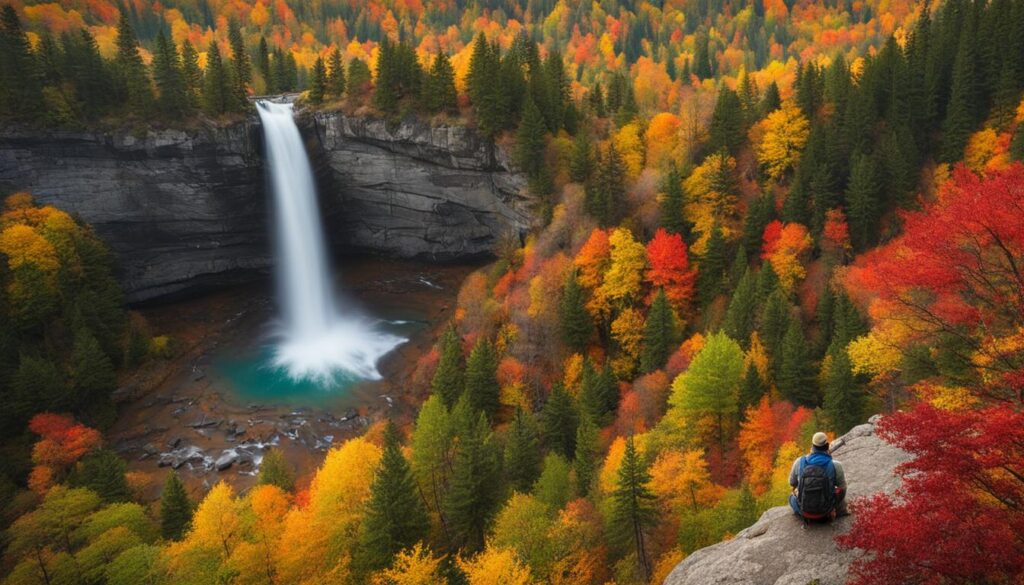
For the adventurous and experienced hikers, Lake Clark National Park offers a selection of challenging trails that will push your limits and reward you with breathtaking views. These hard hiking trails provide an opportunity to truly immerse yourself in the rugged wilderness of the park and test your skills and endurance. However, it’s important to be well-prepared and equipped for these demanding trails.
Telaquana Route
One of the popular hard hiking trails in Lake Clark National Park is the Telaquana Route. This trail stretches approximately 42 miles and offers a remote, backcountry experience. The Telaquana Route takes you through diverse terrain, including river crossings, dense vegetation, and stunning alpine meadows. It is a challenging trail that requires navigation skills and the ability to navigate through rugged terrain. Hikers should be prepared for the possibility of encountering wildlife, including bears, and be equipped with bear safety knowledge and gear.
Fishtrap Lake to Snipe Lake
Another challenging hiking trail in Lake Clark National Park is the Fishtrap Lake to Snipe Lake route. This trail spans around 16 miles and takes you through a scenic and remote wilderness. The trail includes steep climbs, dense forests, and river crossings. Hikers should be prepared for physically demanding sections and be equipped with appropriate gear, including sturdy hiking boots and trekking poles for stability. It’s important to plan ahead, check weather conditions, and pack extra supplies, as this trail can be challenging and unpredictable.
| Trail Name | Difficulty Level | Distance | Features |
|---|---|---|---|
| Telaquana Route | Hard | Approximately 42 miles | Remote backcountry experience, river crossings, alpine meadows |
| Fishtrap Lake to Snipe Lake | Hard | Approximately 16 miles | Steep climbs, dense forests, river crossings |
When hiking on these hard trails, it’s essential to be well-prepared and have the necessary skills and equipment. Make sure to carry a map, compass, and GPS device to navigate through the challenging terrain. It’s also important to have proper clothing layers, including waterproof and breathable gear, as weather conditions in Lake Clark National Park can change rapidly. Always inform someone about your hiking plans and expected return time for safety purposes.
Embarking on these hard hiking trails in Lake Clark National Park will provide a thrilling and rewarding experience. As you push yourself beyond your comfort zone, you’ll witness the untouched beauty of the park and create lasting memories in this pristine wilderness.
Hiking in Summer vs Winter in Lake Clark National Park
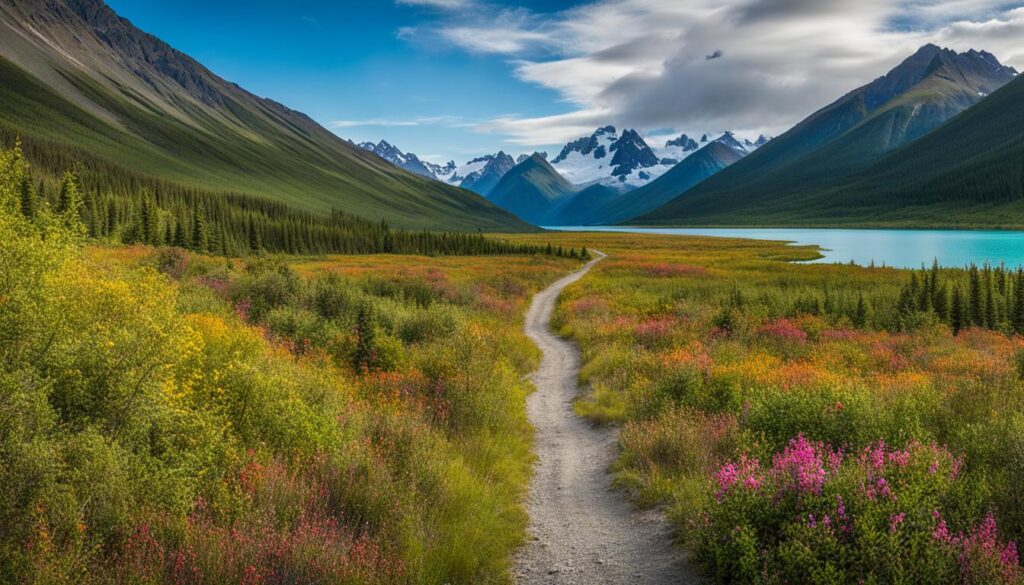
When it comes to hiking in Lake Clark National Park, the experience can vary significantly depending on the season. The park, located in Alaska, offers unique opportunities for outdoor adventures in both summer and winter. Let’s explore the differences between hiking in the warmer months and tackling the trails in the snowy wonderland of winter.
Summer Hiking
In the summer, Lake Clark National Park comes alive with longer daylight hours and milder weather. This is the prime season for embarking on longer hikes and exploring the vast backcountry. The park’s scenic trails are accessible, and the lush landscapes are in full bloom. It’s the perfect time to witness the vibrant colors of wildflowers and catch glimpses of wildlife in their natural habitat.
However, summer hiking in Lake Clark does come with its challenges. Rain is a common occurrence, so hikers should be prepared with waterproof gear. Additionally, the park is home to a significant population of brown bears, so hikers must take precautions and carry bear spray. It’s important to be knowledgeable about bear safety and follow proper protocols to ensure a safe and enjoyable hiking experience.
Winter Hiking
Winter transforms Lake Clark National Park into a magical snowy wonderland. Hiking in the winter offers a unique experience, with opportunities for snowshoeing and a chance to witness the park’s stunning landscapes draped in a white blanket of snow. The serene atmosphere, frozen lakes, and snow-capped mountains create a picturesque setting for outdoor enthusiasts.
However, winter hiking requires additional preparation and gear. The cold temperatures demand appropriate clothing layers to stay warm and dry. It’s crucial to have sturdy winter boots, snowshoes, and trekking poles for stability. Avalanche awareness is also essential, as the park’s mountainous terrain can be prone to avalanches. It’s recommended to check weather conditions, consult with park rangers, and follow safety guidelines when venturing out on winter hikes.
In conclusion, whether you choose to hike in the summer or winter, Lake Clark National Park offers a wide range of trails and breathtaking landscapes to explore. Both seasons present their own unique charms and challenges. From the vibrant beauty of summer to the tranquil splendor of winter, every hiking adventure in Lake Clark is an opportunity to connect with nature and create unforgettable memories.
Historical Significance of Lake Clark National Park
The Ancestral Homeland of the Dena’ina People
Lake Clark National Park holds immense historical significance as it is the ancestral homeland of the Dena’ina people, who settled in the region over a thousand years ago. The park serves as a testament to their rich cultural heritage and traditional practices. Exploring the historical sites within the park offers a unique opportunity to learn about the deep-rooted history and customs of the Dena’ina people.
Preserving Cultural Heritage
The park has diligently worked to preserve and protect the cultural heritage of the Dena’ina people. One such example is the Kijik National Historic Landmark and Archeological District, which is located within Lake Clark National Park. This site is of great importance as it provides insights into the past through artifacts, ancient structures, and archaeological remains. It serves as a reminder of the enduring connection between the Dena’ina people and their ancestral land.
Discovering the Dena’ina Way of Life
Visitors to Lake Clark National Park have the opportunity to delve into the Dena’ina way of life by exploring the historical sites and learning about their traditional practices. The park provides a platform for cultural exchange and appreciation, allowing visitors to gain a deeper understanding of the Dena’ina people’s rich history and their harmonious relationship with the natural world.
Preserving a Legacy for Future Generations
By preserving the historical significance of Lake Clark National Park, we ensure that the stories and traditions of the Dena’ina people are safeguarded for generations to come. It is a collective responsibility to honor and respect the cultural heritage of the Dena’ina people and the role they have played in shaping the region’s history.
| Historical Sites | Description |
|---|---|
| Kijik National Historic Landmark and Archeological District | An important site that offers insights into the history and heritage of the Dena’ina people through artifacts and ancient structures. |
| Traditional Villages | These villages provide a glimpse into the traditional way of life of the Dena’ina people, showcasing their customs and practices. |
| Cultural Centers | These centers serve as repositories of knowledge, offering educational programs and exhibits that celebrate the Dena’ina culture. |
Image source: Lake Clark National Park
Geological Wonders of Lake Clark National Park
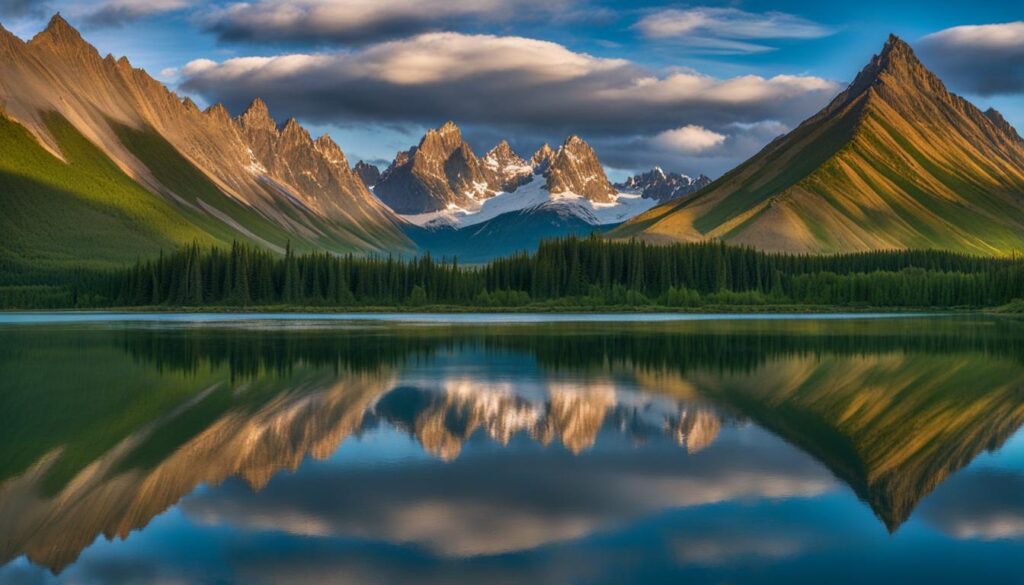
The geological wonders of Lake Clark National Park are a testament to the raw power and beauty of nature. From towering volcanoes to carved landscapes, the park offers a glimpse into the Earth’s geological history. Two active volcanoes, Mount Iliamna and Mount Redoubt, dominate the skyline, their snow-capped peaks contrasting against the vibrant greenery of the surrounding terrain.
The volcanic activity has shaped the park’s landscapes, leaving behind a trail of evidence for visitors to explore. Glaciers have carved deep valleys and left behind stunning fjords, creating a dramatic and awe-inspiring backdrop. The constant movement of ice and rock has sculpted striking features, including cliffs, waterfalls, and glaciers, that are a testament to the ever-changing nature of the park.
The geological wonders of Lake Clark National Park are a testament to the raw power and beauty of nature.
One of the highlights of the park is the Turquoise Lake, a breathtaking body of water nestled amidst the mountains. Its stunning color is a result of the minerals carried by the glaciers that feed into the lake. Hiking along the shores of Turquoise Lake provides an opportunity to witness the magnitude of the park’s geological forces up close.
Exploring the geological wonders of Lake Clark National Park offers a unique perspective on the Earth’s history and the processes that have shaped our planet. The park’s diverse landscapes, from rugged mountains to pristine lakes, are a testament to the power of geological forces and the endless beauty they create.
Wildlife in Lake Clark National Park
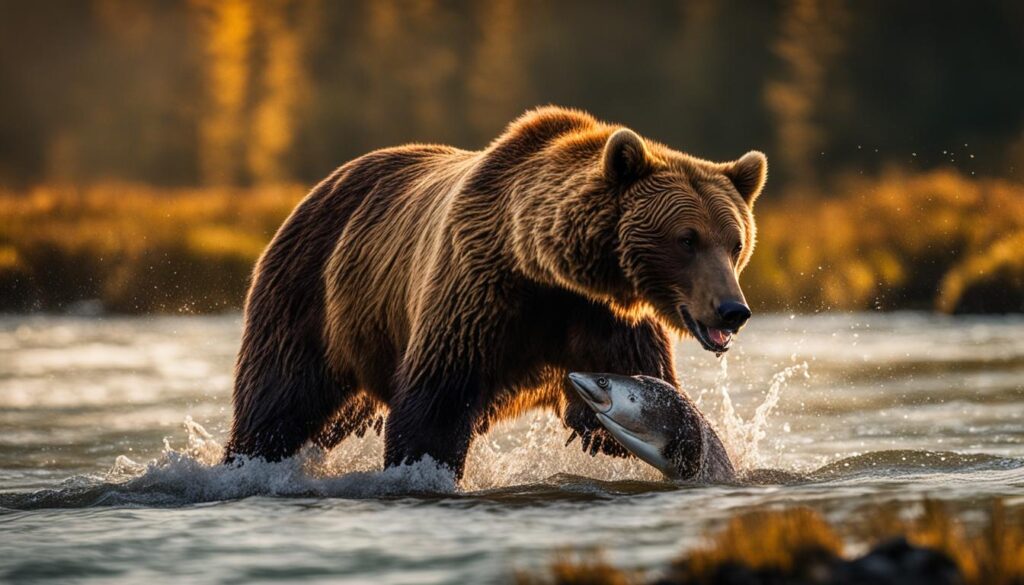
Lake Clark National Park is home to a diverse range of wildlife, offering visitors a unique opportunity to observe and appreciate the natural beauty of these creatures in their native habitat. From majestic brown bears to graceful moose and elusive caribou, the park is teeming with animal life.
The star attraction of Lake Clark National Park is undoubtedly the brown bears. With a healthy population of these magnificent creatures, visitors have a high chance of spotting them during their visit. Whether they are fishing for salmon in the rivers or foraging for berries in the meadows, watching these bears in action is a truly awe-inspiring experience.
In addition to brown bears, other wildlife commonly seen in the park includes moose, caribou, Dall sheep, wolves, and a variety of bird species. The park’s diverse ecosystems provide ample food and shelter for these animals, making it an ideal habitat for them to thrive.
Notable Wildlife Sightings:
- Brown bears fishing for salmon in the rivers
- Moose grazing along the shores of the lakes
- Caribou migrating across the vast tundra
- Dall sheep navigating the rugged mountain cliffs
- Wolves roaming through the forests
Whether you’re an avid wildlife enthusiast or simply appreciate the beauty of nature, a visit to Lake Clark National Park promises unforgettable wildlife sightings and a deeper connection with the natural world.
| Animal | Population | Habitat |
|---|---|---|
| Brown Bears | Approximately 200-250 | Rivers, meadows, and forests |
| Moose | Approximately 700 | Lakeshores and wetlands |
| Caribou | Approximately 1,500 | Tundra and high alpine areas |
| Dall Sheep | Approximately 500-600 | Mountain cliffs and slopes |
| Wolves | Exact population unknown | Forests and open tundra |
As you explore Lake Clark National Park, be sure to keep your eyes peeled for these fascinating creatures and enjoy the thrill of witnessing wildlife in their natural habitat.
Scenic Viewpoints in Lake Clark National Park
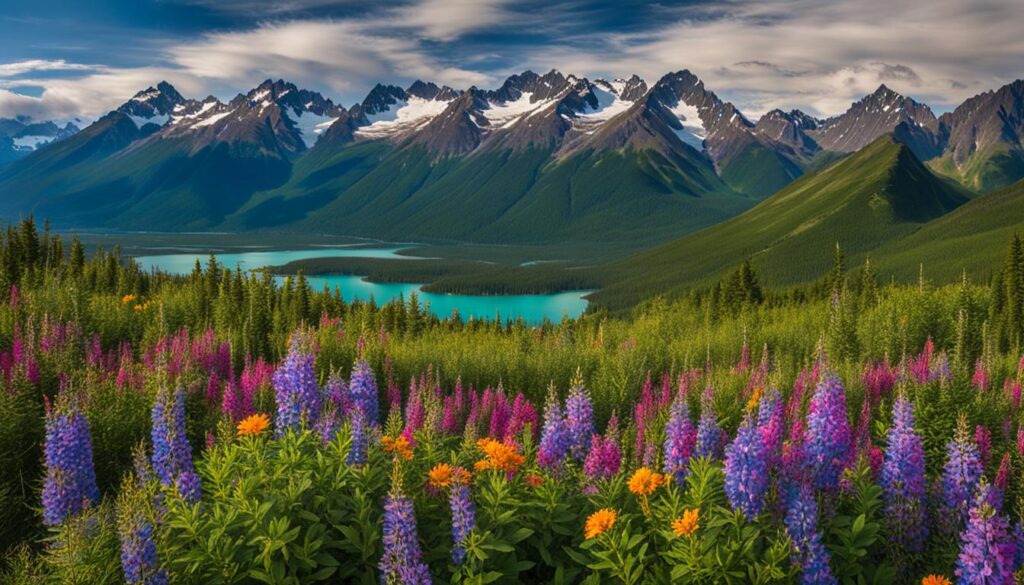
If you’re a nature lover and photography enthusiast, Lake Clark National Park offers a plethora of scenic viewpoints that will take your breath away. These viewpoints provide mesmerizing vistas of the park’s pristine landscapes, allowing you to capture stunning photographs and create lasting memories.
One of the must-visit spots is Chinitna Bay, known for its picturesque coastal brown bears and sweeping views of the Cook Inlet. It’s a perfect place to witness these magnificent creatures in their natural habitat while enjoying the stunning beauty of the surrounding area. Be sure to have your camera ready for some incredible wildlife photography opportunities.
Crescent Lake is another remarkable viewpoint that offers panoramic views of the park’s serene landscapes. With its crystal-clear waters reflecting the surrounding mountains, it’s a tranquil oasis that will leave you in awe. Take a moment to soak in the tranquility and capture the beauty of this hidden gem.
No visit to Lake Clark would be complete without a trip to Silver Salmon Creek. Here, you can capture breathtaking photographs of coastal brown bears in their natural habitat. Immerse yourself in the rugged beauty of the Cook Inlet coastline as you watch these majestic creatures fishing for salmon.
Majestic Beauty and Historical Significance
“Lake Clark National Park is a treasure trove of scenic viewpoints that showcase the park’s majestic beauty. From towering mountains to crystal-clear lakes, every turn offers a new opportunity for awe-inspiring photographs. Whether you’re an amateur photographer or a seasoned pro, Lake Clark’s scenic viewpoints will captivate your senses and leave you with memories to cherish.”
Table: Scenic Viewpoints in Lake Clark National Park
| Viewpoint | Description |
|---|---|
| Chinitna Bay | A coastal area known for its brown bears and stunning views of the Cook Inlet. |
| Crescent Lake | A tranquil lake with crystal-clear waters, surrounded by majestic mountains. |
| Silver Salmon Creek | A prime location to observe coastal brown bears fishing and enjoy the scenic beauty of the Cook Inlet coastline. |
These scenic viewpoints offer a glimpse into the natural wonders of Lake Clark National Park. Make sure to visit these locations during your trip to capture the essence of this extraordinary wilderness and create memories that will last a lifetime.
Conclusion
As an outdoor enthusiast, Lake Clark National Park has captured my heart with its breathtaking landscapes, abundant wildlife, and thrilling adventures. This Alaskan gem offers an unparalleled experience for hiking enthusiasts of all levels. Whether you’re a beginner looking for easy trails or an experienced adventurer seeking a challenge, Lake Clark has something for everyone.
Before embarking on your hiking journey in Lake Clark National Park, it’s important to keep a few tips in mind. First and foremost, always respect the wilderness and leave no trace behind. Pack essentials such as a map, compass, extra clothing, food, and water. Bear safety is crucial, so make sure to carry bear spray, travel in groups, and be aware of your surroundings. Lastly, check the weather conditions and be prepared for sudden changes.
Outdoor adventures await you at Lake Clark National Park. Immerse yourself in the pristine beauty of nature, witness awe-inspiring wildlife sightings, and capture unforgettable memories. From the easy trails that showcase the park’s natural splendor to the challenging routes that push your limits, Lake Clark promises an experience like no other. Lace up your hiking boots, pack your sense of adventure, and get ready to explore the wonders of Lake Clark National Park.
FAQ
Are there easy hiking trails in Lake Clark National Park?
Yes, Lake Clark offers a variety of easy hiking trails suitable for all skill levels. Some popular options include the routes to Beaver Pond, Tanalian Falls, and Kontrashibuna Lake near the visitors center in Port Alsworth.
Are there challenging hiking trails in Lake Clark National Park?
Certainly! Lake Clark also offers challenging trails for experienced hikers and adventurers. The Telaquana Route and the Fishtrap Lake to Snipe Lake route are popular options for those seeking a more rugged hiking experience.
What should I expect when hiking in Lake Clark National Park?
Hiking in Lake Clark can vary depending on the season. In the summer, be prepared for rain, bugs, and potential encounters with bears. In winter, additional gear and precautions are necessary due to the cold temperatures and potential for avalanches. Always check weather conditions and come prepared with appropriate clothing and equipment.
Does Lake Clark National Park have historical significance?
Yes, Lake Clark holds historical significance as the ancestral homeland of the Dena’ina people. Visitors can explore historical sites, such as the Kijik National Historic Landmark and Archeological District, which offer insights into the rich history and heritage of the Dena’ina people.
What geological wonders can be found in Lake Clark National Park?
Lake Clark is known for its geological wonders, including active volcanoes and stunning landscapes shaped by glaciers. The park is home to two active volcanoes, Mount Iliamna and Mount Redoubt, which contribute to the geological diversity of the area.
What kind of wildlife can I encounter in Lake Clark National Park?
Lake Clark is renowned for its diverse wildlife population. Visitors may spot brown bears, moose, caribou, Dall sheep, wolves, and a variety of bird species. Observing wildlife behaviors and capturing unique sightings through photography are popular activities in the park.
Are there scenic viewpoints in Lake Clark National Park?
Absolutely! Lake Clark offers numerous scenic viewpoints that provide breathtaking panoramic views of the park’s landscapes. Chinitna Bay, Crescent Lake, Silver Salmon Creek, and Twin Lakes are popular areas for capturing stunning photographs and enjoying the natural beauty of Lake Clark.

